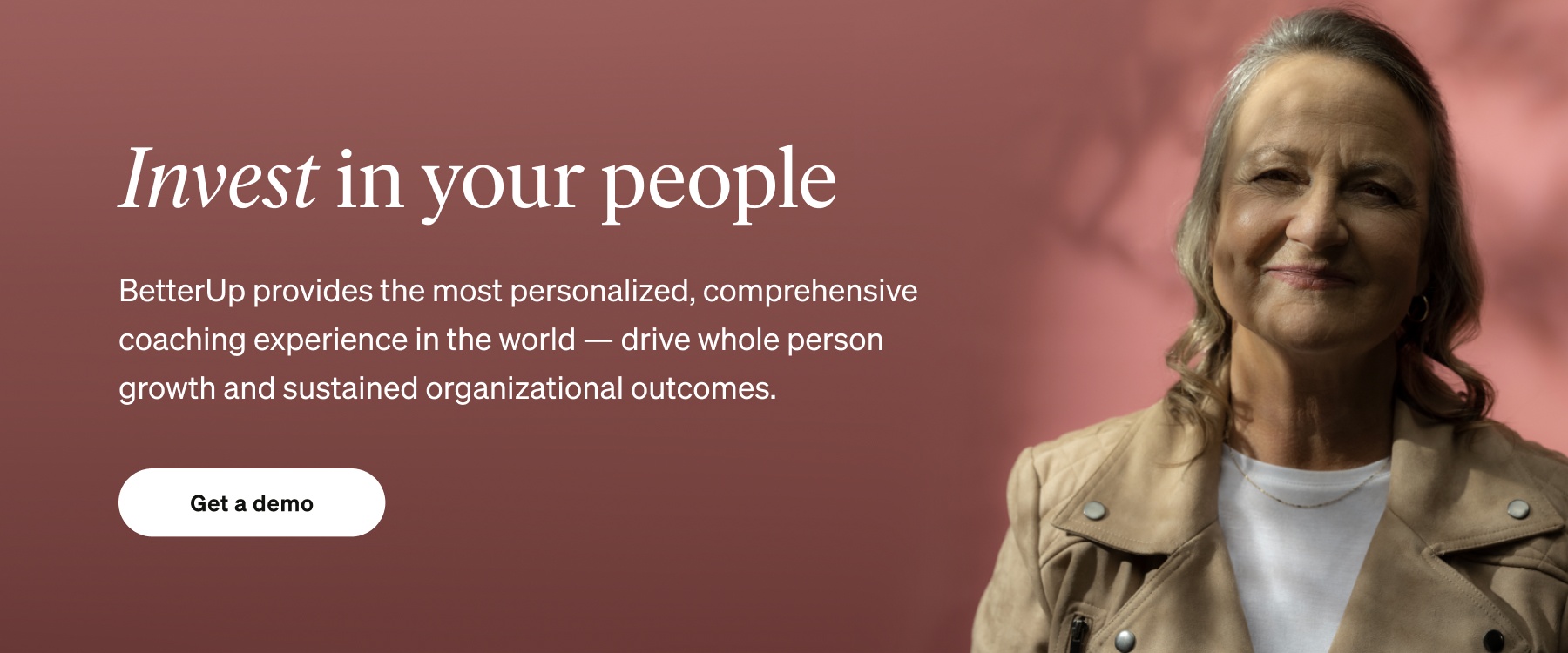-
For Business
For Business
Products
LeadBuild leaders that accelerate team performance and engagement.
Care™Drive productivity through sustained well-being and mental health for all employees with BetterUp Care™.
Solutions
Sales PerformanceTransform your business, starting with your sales leaders.
Diversity & InclusionFoster a culture of inclusion and belonging.
Customers
Case StudiesSee how innovative companies use BetterUp to build a thriving workforce.
- For Individuals
-
Resources
Resources
LibraryBest practices, research, and tools to fuel individual and business growth.
EventsView on-demand BetterUp events and learn about upcoming live discussions.
BlogThe latest insights and ideas for building a high-performing workplace.
ResearchInnovative research featured in peer-reviewed journals, press, and more.
- About

Research from McKinsey & Company finds that of employees who voluntarily leave their jobs, 35% cite a lack of career development and promotion opportunities as their reason.
If the Great Resignation has taught us anything, it’s that employers must do more to invest in employee retention.
And according to data from LinkedIn’s 2020 Global Talent Trends report, employees at companies that hire and promote more internal candidates stay 41% longer than workers at companies with lower internal hiring rates.
Having a promotion policy in place to recognize employees for their hard work is a critical piece of the puzzle to retaining more workers.
A clear promotion policy makes career planning and growth opportunities easier to design and follow. Here’s how to create one for your organization.
What is a promotion policy?
A promotion policy is a set of guidelines that define how, when, and why an employee is eligible for a promotion. The company’s human resources team develops these guidelines to provide specific and measurable goals for employees to qualify for a promotion.
“Promotion policies are meant to clarify any pay adjustments, title, and responsibilities that change with rank and job category,” says Dannie Lynn Fountain, a Senior SWE Sourcer at Google. “In other words, it's a road map to career growth for both employees and the organization.”
Employee promotion policy template:
A promotion policy recognizes hardworking employees by justifying promotion decisions through objective evidence. A promotion policy template helps management devise qualifications effectively. Here’s one sample template:
|
Employee Promotion Policy A guide to verifying and awarding promotions of deserving employees within the organization. |
|
Type of Promotion Horizontal Promotion: Increasing the pay scale of an employee without a change in job title. Vertical Promotion: Promoting the employee to a senior position with a pay raise. Career Mobility Promotion: Promoting an employee to a different unit with a pay raise. |
|
Guidelines for Managers [Define the set of guidelines that cover both merit and ethics that management should consider when promoting an employee to a new job.] Example:
|
|
Eligibility [Highlight the qualities and KPIs an employee must meet to be considered for career advancement. These can be decided by the manager and director responsible for the employee.] Example:
|
|
Career Growth Ladders [Define the career growth plans for each position.] Example:
|
|
Promotion Clearance [Define the departments that can verify the employee’s promotion.] Example:
|
|
Internal Hiring [Define the policy of internal hiring of current employees to new positions.] |
|
Applicable from: DD-MM-YYYY |
What not to include: Tenure or formal education requirements. “Both are possible bias/discriminating factors,” warns Fountain.
Why are promotion policies important?
According to Fountain, “Promotion policies are critical for supporting internal mobility. By having a promotion policy, the path to career growth is clear, and employees can work towards future goals.”
“As well, the clearly defined parameters promote equity and reduce the advancement gap, by making the expectations by role and rank clear across all individuals in that role,” Fountain shares. Transparent policies serve as reference points for employees to track their performance.
What is the purpose of a promotion policy?
A promotion policy adds structure to an organization’s promotion process. It is aimed to develop policies with specific goals in mind, such as a leadership development plan, that converge to make a more fair work environment. Below are some common goals companies set.
Career growth plan
Employees stick around longer in a company when they see a clear career growth plan for themselves. Promotion policies make it easy to map these plans for each position by developing promotion indicators.
Eradicate discrimination
Not having an objective guidelines leaves room for workplace discrimination. It can also lead to emotional bias and favoritism. Harmful workplace practices such as religious or gender discrimination may persist in organizations without a promotion policy. A promotion policy creates transparency in the process by ensuring promotions are based solely on merit and work ethic.

Internal hiring
When opening new roles, companies can opt for internal hiring rather than hiring external candidates. HR management should carefully consider the pros and cons of internal hiring. When you have job openings, internal hiring saves on training costs and hiring time. It also encourages talent development within the organization.
Reward system
If we zoom out from the nitty-gritty of employee promotion policy, we see it is simply a structured reward system for capable employees. Managers can promote their direct reports when they meet expectations.
An established reward system keeps employees motivated to excel. Yet, research from Workhuman and Gallup finds that only 36% of employees report their organization having some sort of recognition system in place.
Employee retention
One of the top indicators of a subpar company culture is a high employee churn rate. Many businesses that aren’t able to retain workers have poor employee relations. Having a transparent promotion policy helps increase employee retention. It reduces vacancies because it reassures your staff that the opportunity exists for them to make it to the next level. This could be in the form of a higher position, higher pay, and more responsibilities.
How do promotion policies influence recruitment?
“Promotion policies guide new hire leveling (what rank/job title should a new hire have based on their background) and aid recruiting in having conversations about internal mobility,” says Fountain.
Setting professional development goals at work makes it easy to create a development ladder for employees by hiring internally.
Organizations should thoughtfully choose between internal and external recruitment. Excessive internal recruitment shrinks teams and causes potential understaffing. But excessive external hiring can cause the company to over-staff. Thoughtful hiring strategies avoid both these recruitment problems while promoting employee development internally.

Essential components of a promotion policy
Eligibility
An employee is deemed eligible for a promotion if they meet their defined KPIs and have the mindset to excel further. Evaluating eligibility requires the employee’s manager to find the balance between objective and subjective evaluation. The criteria for promotion are set at the bi-annual or annual performance management meetings by managers and directors.
Career alignment
A promotion policy for each position should follow a defined career growth path. For example, a Graphic Designer’s next promotion should be Senior Graphic Designer and then Head Designer. It wouldn’t make sense to promote a graphic designer to an Operations Manager position unless they are looking for career mobility within the organization.
Fair opportunity
Giving a fair chance of promotion to all employees is essential for a promotion policy. This includes removing gender discrimination, ethnic discrimination, or nepotism from the promotion process. Providing a fair opportunity to excel to all employees reveals healthy transparency within an organization’s operations and keeps employees motivated to climb the promotion ladder.
Pair your promotion policy with a fair, consistent performance appraisal process. This lets workers know where they stand, how they can improve, and why others may have been promoted instead of them.
How to establish a promotion policy
Here’s how companies can develop and educate the workforce about a new promotion policy:
- Perform an Audit: An audit of all current roles and any existing succession plans should be done first to identify gaps.
- Define Career Paths: HR and top management should map out career paths to ensure each position has a promotion pipeline in place.
- Add Eligibility Criteria: For each promotion, define eligibility criteria with quantifiable goals and metrics that can be checked for each candidate employee.
- Employee Handbook: Add the career paths along with the promotion eligibility criteria to the employee handbook for everyone to access. Keep the employee handbook updated with each new development.
- Management Training: Hold management training programs to help managers understand the employee promotion policy and their role in making those decisions.
Tips for communicating a new promotion policy
Once a new or updated promotion policy is ready, circulate it effectively to all employees. Here are some helpful tips for communicating the promotion policy across the organization:
1. Company-wide updates
Adding the promotion policy changes to the employee handbook doesn’t necessarily mean employees will read and understand it. HR can send a company-wide email to alert all employees to changes in the promotion policy. They may also conduct an all-hands meeting to discuss it and answer any questions. The employee promotion policy should also be paired with internal job openings.
2. Reinforce knowledge
When changes are made to the existing promotion policy, email updates should be sent across the organization. Some companies also develop a mandatory internal quiz to ensure all employees know and understand the new promotion policy.

Promotion policy FAQs
When should I implement a promotion policy?
Implement a promotion policy when your company is big enough to have hierarchies. Normally, companies with ten or more employees should have a promotion policy in place to give opportunities for career growth.
Do small businesses need promotion policies?
Businesses consisting of small teams of under ten employees may not need a promotion policy. However, Fountain would argue that all companies that plan to advance talent internally should have promotion policies in place.
Promotion policies help structure a business when it divides functional teams in its growth stage. As their business enters this stage, founders should consider implementing a policy to internally promote employees to managerial positions before hiring new talent.
Are there consequences to not creating a promotion policy?
Not having a defined promotion policy gives way to unfair promotions and discrimination in the workplace.
“The advancement gap (the gap that occurs when marginalized individuals are promoted at a slower rate than others) can be mitigated through an effective promotion plan,” says Fountain. “A promotion plan also helps guard against other equity issues and EEOC issues.”
Not having a promotion policy may discourage talented candidates from applying to the organization. This could be due to an (apparent) lack of value for hard work or career growth milestones in place.
Keep empathy at the heart of your employee promotion policy
At the end of the day, employees simply want to know that they're working towards something meaningful and that they have a fair shot at achieving it.
While your company's mission and ESG initiatives can help support that, your workers also need to know what's in it for them. They want to know how your organization intends to help them meet their professional goals. Having a formal promotion policy and communicating it to your staff can go a long way toward employee retention and engagement.
Some employees may have a record of good performance and be eager to reach a higher level or move laterally within your organization. If they don't have the perfect mindset or skillset, coaching is an excellent tool to help them get there. Investing in your team’s career development is a powerful way to show them that you care.
Allaya Cooks-Campbell
BetterUp Staff Writer





